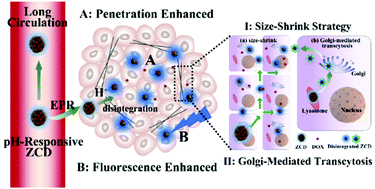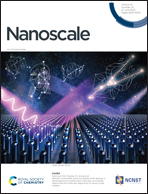ZIF-based carbon dots with lysosome-Golgi transport property as visualization platform for deep tumour therapy via hierarchical size/charge dual-transform and transcytosis†
Abstract
The poor penetration of nanomaterials in solid tumours and difficulty in monitoring their penetration depth are major obstacles in their application for the treatment of solid tumours. Herein, pH-responsive carbon dots (ZCD) based on a zeolitic imidazolate framework (ZIF-8) were fabricated to achieve the deep delivery of the chemotherapeutic doxorubicin (DOX) via a hierarchical size/charge dual-transformation and transcytosis. The as-prepared ZCD accumulated in the solid tumour and the acidic tumour microenvironment further triggered its decomposition. Firstly, ZCD was decomposed by the weakly acidic extracellular microenvironment of the solid tumour, enabling it to transform into small and neutrally charged particles. Subsequently, these particles were endocytosed by lysosomes, and further disintegrated into smaller and positively charged particles, which could target the Golgi apparatus. Consequently, ZCD delivered DOX deep into the solid tumour via a size-shrinking strategy and Golgi-mediated transcytosis, thus significantly improving its antitumour efficacy. In addition, carbonization endowed ZCD with superior fluorescence property, which was enhanced in the acidic microenvironment, thus improving the sensitivity and accuracy of ex vivo monitoring of the penetration depth of the nanomedicine in real time. Collectively, our results confirmed that the carbon dots obtained via the direct carbonization of ZIF-8 simultaneously exhibited enhanced deep penetration into solid tumours and fluorescence, which could be monitored, and that the carbonization of functional materials is effective to enhance their fluorescence, and further broaden their applications.



 Please wait while we load your content...
Please wait while we load your content...